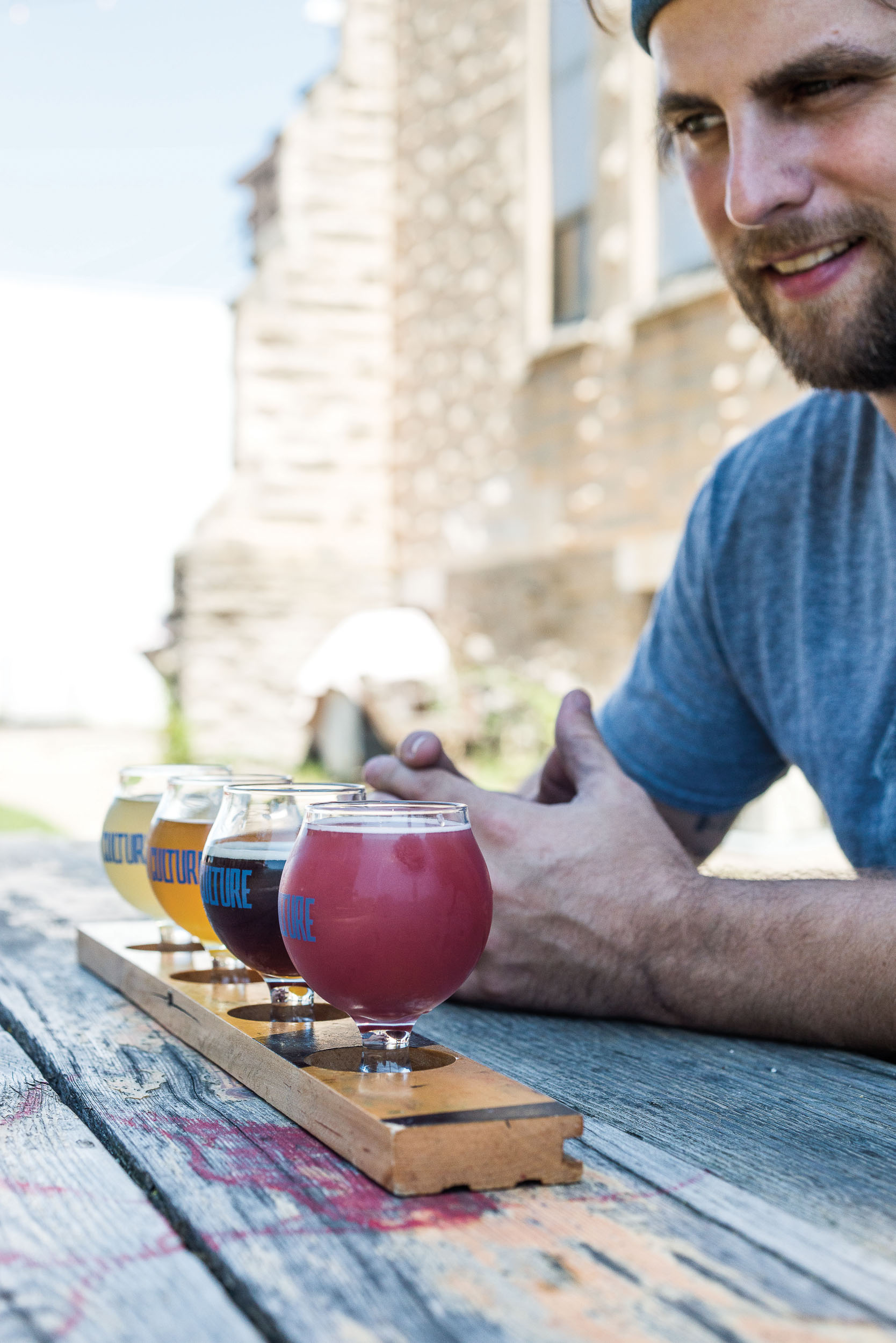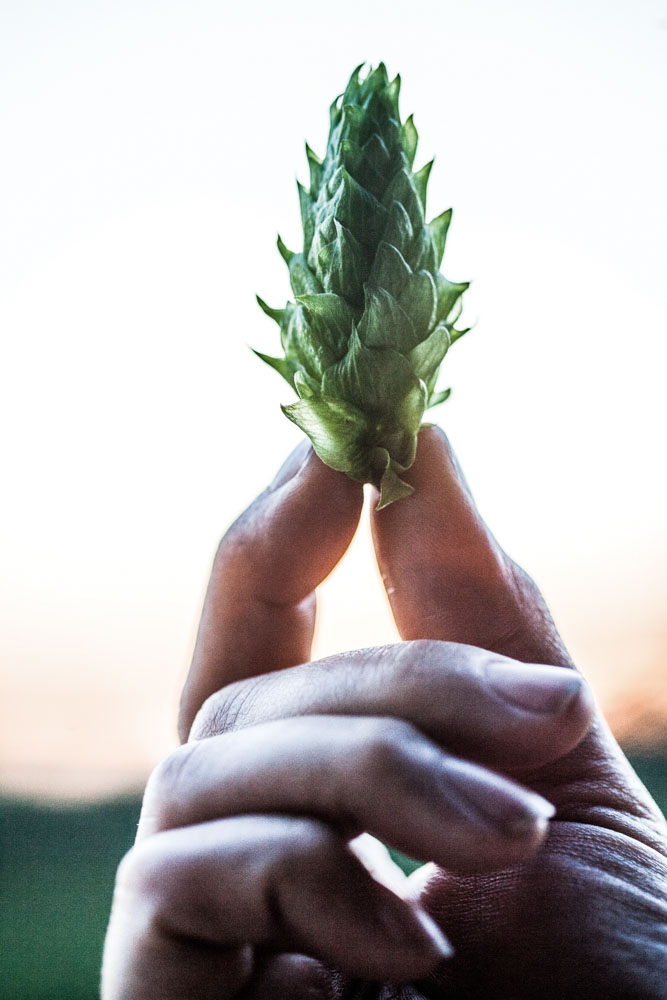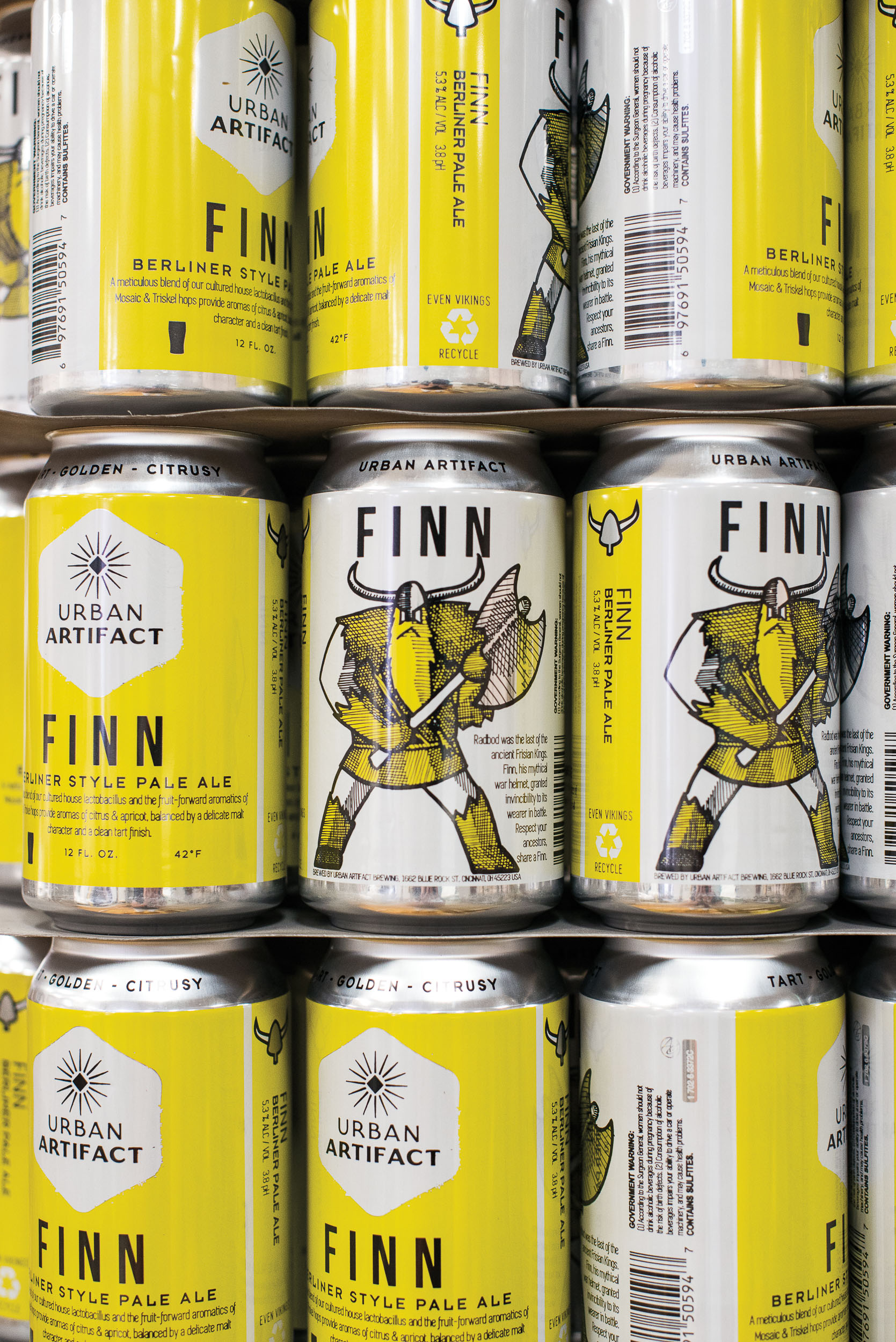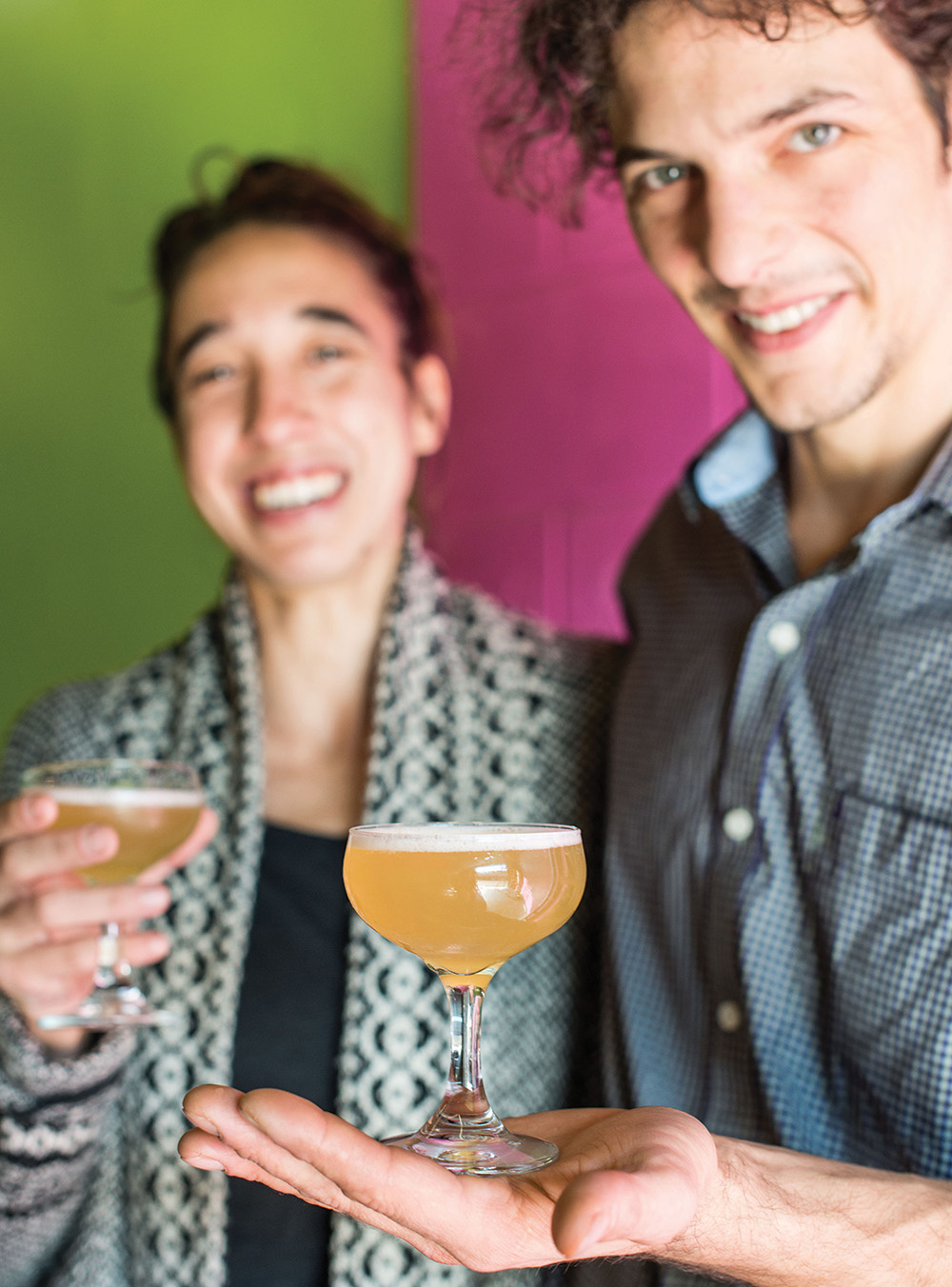Beer Meets Food

Urban Artifact focuses on flavor to push the boundaries of what beer is—and what it can be.
photography by Julie Kramer
A conversation about the relationship between beer and food can quickly become pretentious. But the brewers at Urban Artifact use these types of discussions to reimagine and extend their definition of craft beer. Their ethos—embracing fearless creativity, questioning conventional wisdom, exploring flavor combinations, and eschewing style guidelines—has led to a focus on tart, wild, and fruited ales that embody local connections and terroir. While the Ohio Valley has seen huge growth in the number of local breweries, Urban Artifact is truly producing a local beer.
Urban Artifact opened in April 2015 in St. Patrick’s Catholic Church in Northside, the project of partners Bret Kollmann-Baker, the head of brewing operations; Scott Hand, the chief of organizing; and Scotty Hunter, the chief of strategic development. Head brewer Josh Elliott joined the team just as they ramped up production. A passionate home brewer before making it a career (he started at Listermann Brewing Co.), Elliott has always been interested in concocting alternative beer styles, using wild yeast, and experimenting with foraged ingredients. The chance to explore these aspects further drew him to Urban Artifact.
More often than not, Elliott’s inspiration comes from the food industry rather than the beer industry. When baker friend Dory Sanders introduced him to The Flavor Bible, a staple in culinary circles, he described it as a revelation. “The Flavor Bible immediately became a vital resource as soon as I saw the contents; what would normally take months of research to work out effective flavor combinations was reduced to the time it took to find a page,” Elliott says. “I stared at the book for 20 minutes when I was first handed it, wondered why I had never seen it in any brewery library before. This book belongs in every brewery next to Radical Brewing and Brewing Classic Styles.”
The Flavor Bible’s lessons on layering and combining flavors have become central tenets of the way the Urban Artifact brewers approach beer. They start with a vision of the end product and develop the processes needed to achieve their goal. For example, with Fire Iron, a Midwest Fruit Tart, the goal was to create a beer with malt body but minimal malt flavor as a vehicle to showcase the beer’s mélange of fruit flavors: pink guava, passion fruit, and banana. To deepen the brewery’s culinary approach, they recently hired George Burpee, a Clemson University grad with a degree in food science.
A Truly Local Beer
One significant part of Urban Artifact’s embrace of local terroir was the decision to capture and propagate local yeast to be used in their beers. While this is a labor-intensive process—only about one in 100 of the yeasts they capture ever makes it further than the initial sample—it gives some of their barrel-aged beers distinctive flavors and local character that can’t be found at other breweries.
Wild yeasts are everywhere; capturing them is the challenge. The brewers sanitize a dozen mason jars and fill them with wort (the sugary liquid collected from mashing barley that yeast eats to produce alcohol), then choose a location to place individual jars where they won’t be disturbed. The jars are left open overnight with sanitized cheesecloth over the top. Locations can be outdoors or indoors, in gardens, fields, or even graveyards. The next morning, lids are loosely placed on jars to allow fermentation to begin—one byproduct of fermentation is CO2, so the jars aren’t tightly sealed. Once fermentation is complete, if the sample passes the initial smell test and subsequent taste test, it will be grown up in a larger flask and tested further. When yeasts pass this test, they might be added to barrels, further propagated and experimented with, and, if successful, banked for later usage. All of this information is recorded and tracked; Elliott says that a future goal is to have a book in the tap room that allows visitors to trace the yeast lineage found in the particular beers they are drinking.
Urban Artifact’s yeast collecting process differs from most other breweries, which purchase commercially grown liquid yeast cultures with known pedigrees that are ready to use. While Urban Artifact also uses these cultures, the chance to come across something new and unique with a wild yeast strain is part of what makes their efforts exciting. After all, there are many undocumented wild yeast strains lurking out in the world. A good number of these wild yeasts often produce harsh, unpleasant flavors in addition to alcohol, but there are also those that produce interesting, new, and enjoyable flavors that enhance the final product. That’s the quest: to find the one in a hundred yeasts that will create a one-of-a-kind beer.
Another aspect of embracing local has been an emphasis on foraging as a means to add distinctive flavors to Urban Artifact beers. Spring Grove Cemetery, located less than a mile from the brewery, is a garden cemetery and arboretum that covers 733 acres; Elliott and his colleagues have created a map of the flora found in the cemetery that’s useful in brewing, including quinces, walnuts, chestnuts, European hazelnuts, crabapples, persimmons, and elderflowers. While not all of these foraged components are always in regular use, Elliott says that learning to think about brewing seasonally was invaluable in building a philosophy centered on local seasons and conditions.
One recent creation at Urban Artifact is a series of what they call Midwest Fruit Tart ales. Growing out of their experimentation with using whole fruit in beers—as opposed to fruit juice or flavoring—and playing with the ways that increased fruit levels change the intrinsic balance found in traditional beer styles, these beers have become a primary expression of Urban Artifact’s vision for craft beer.
Kollmann-Baker describes Midwest Fruit Tart ales as having “intense real fruit flavor and aroma, balanced by a moderate to high clean lactic acidity, moderate to high level of alcohol, and a malt profile designed to enhance and support the profoundly decadent nature of these beers.”
Fire Iron is clearly in this mold, as is The Gadget, a sour berry bomb brewed with 1,260 pounds of blackberries, 1,260 pounds of raspberries, and 30 grams of vanilla bean per 30-barrel batch. Other Midwest Fruit Tart beers include Whirligig, a blueberry beer, and Squeezebox, a strawberry beer.
Community Collaboration
Beyond procuring local ingredients, Urban Artifact seeks innovative ways to pair with community partners. Many of these collaborations focus on learning and education rather than public relations; employees perform community service as part of their weekly schedule.
Urban Artifact works with organizations and entrepreneurs outside the brewing industry. Elliott notes that they seek partnerships that enable participants to deepen their community ties and develop greater understanding about each other. For example, last February Urban Artifact hosted an event in the Cincinnati Museum Center’s CurioCity series. They tapped a German-style Union Terminal Beer that was brewed with wild yeast collected on the Union Terminal property, infused with cherries, and aged in wine barrels. It was an opportunity to educate a new audience about wild yeast collection, the brewing process, and fermentation.
Other local projects include working with Happy Chicks Bakery, providing beer that’s used to flavor some of their baked goods, creating food and beer pairing tastings, and having the bakery create special treats for events and tastings at the brewery, including BeWILDerfest, their yearly festival of beer and music. Then there are more beer-specific collaborations, like Pickle, a gose brewed with 1,000 pounds of cucumbers, 2 pounds of fresh dill, 9 pounds of sea salt, and 1.25 pounds of coriander per 30-barrel batch. Brewed for Izzy’s, an iconic Cincinnati deli famous for their Reubens, this beer is intended to taste like the dill pickles the restaurant also serves.
Finally, there are also more traditional collaborations, like bringing together Wolf’s Ridge Brewing and One Line Coffee from Columbus along with Market Garden Brewery from Cleveland to produce War Mug, a Golden Fruited Coffee Sour. Featuring Costa Rican coffee along with peaches, passionfruit, and plums, War Mug offered an elegant balance of flavors that complemented the beer’s lactic sourness, another example of the possibilities found in Midwest Fruit Tart ales.
Moving Forward
Urban Artifact’s successful focus on the intersection between beer and food is evident in their 2017 Good Food Award for Calliope, a fresh hop grand cru made with locally malted Vienna barley, 2-row malt, and locally grown Galena, Columbus, and Centennial hops from Dave Volkman at Ohio Valley Hops. Given to those in the food industry that focus on local, sustainable food economies in conjunction with craftmanship and strong local community support, this award reflects the values that Urban Artifact has grown into over the last year and a half.
Their epicurean embrace of craft beer, of making the vision of what local beer can be, pushes the idea of craft beer forward towards embracing community.
Tom Morgan is an Associate Professor of English at the University of Dayton with a particular interest in Paul Laurence Dunbar. He has been homebrewing for fifteen years, and is always looking for an excuse to read, write, and talk about local beer. Besides volunteering at local breweries, he is also a BJCP National-level beer judge. You call follow him on Instagram at whatweredrinking





